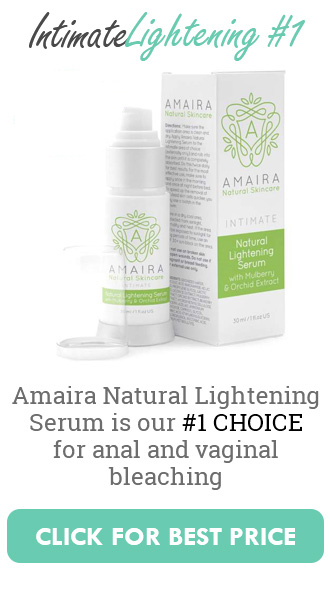Anal bleaching is the practice of lightening the anus so that it’s closer to the skin tone of the rest of your genital area.
There are many reasons why anal bleaching has become popular. The trend has its beginnings in adult film, but has since gained widespread acceptance with both celebrities and everyday people.
Personal reasons can vary too. Some find that they’re uncomfortable with having a dark anus, and bleaching is a great way to improve self-confidence. For others, it’s about pleasing their partners, or purely for aesthetic reasons.
Is anal bleaching safe? Yes. But, as with many other beauty procedures, there are good and bad ways to lighten your bum. Doing a bit of research before bleaching your bumhole is a great way to ensure you get the best results with minimal risk!
So, before you take the plunge into the world of anal bleaching, here are a couple of things you should know before lightening your anus.
DIY Anal Bleaching vs. Salon

Ok, first things first!
The most efficient way to bleach your anal area is to get it done at a professional salon, where beauty professionals will use laser treatments or peels to bleach your anal area permanently. It needs to be said that this is a pretty expensive option, especially if you go for the laser treatment. It also involves a relatively long recovery time, during which you’ll feel like… Well.
Let’s just say that you’ll feel a burning sensation on your cornhole. It will feel as if your anal area has been sunburned, which is obviously pretty unpleasant. However, after three weeks or so, the unpleasant sensations will subside leaving you with permanent results. That said, there still is a bit of regular necessary maintenance to ensure that the darker pigmentation doesn’t return.
A far more popular option is the “do it yourself at home” method.
There are many intimate lightening products on the market that can be used for anal bleaching purposes. They vary quite a lot in quality, price and effectiveness, and again, you’ll have to do your research to find a cream that works for you. Many of these products work by inhibiting melanin production as well, which means that they may take some time to work and will require regular upkeep.
So what is the typical anal bleaching product made of? Let’s see.
Active Ingredients

If you do choose the DIY route and start looking at various intimate lightening creams, gels and serums, make sure you familiarize yourself with the most common active ingredients.
While anal bleaching products are regulated by the FDA in the US, that doesn’t mean that everything out there is completely safe or good for you. For example, there are still creams out there that contain a compound called hydroquinone. Hydroquinone is a very efficient skin lightener, but subsequent research and experience indicate that its effectiveness comes at a cost. Hydroquinone is a very harsh chemical that can cause burns and severe irritation, and last but not least, it has also been linked to skin cancer. So if you see a cream that contains hydroquinone, best avoid it at all costs.
But, here’s the good news. There are many good, and even naturally-based alternatives to hydroquinone.
The most effective ones are alpha arbutin and various alpha-hydroxy acids (AHA). These ingredients are usually derived from natural sources and are much gentler on your skin. They may be slightly less effective and take longer to show results, but we’d say that’s a fair price to pay for protecting your health.
Risks
No matter whether you choose a DIY treatment or a professional procedure, there are always some risks involved. The major ones, of course, are rashes, skin irritation or allergic reactions. However, the adverse effects will vary depending on the treatment you choose.
For example, laser treatments are quite harsh as they remove the top layer of your skin, revealing the less-pigmented area below. This will result in your skin being hurt, sensitive and irritated until it heals.

On the other hand, skin creams can also produce unexpected side effects, particularly if you’re allergic to one of the active ingredients. A small number of people with sensitive skin react badly to Kojic acid, so make sure you do a patch test before using any anal bleaching cream.
Another risk is the possibility of hyperpigmentation. When coming in contact with bleaching ingredients, some skin types react to the damage by producing a lot more melanin. This, in turn, results in darker patches which is the exact opposite of what you’d want. It needs to be said that this happens mostly during surgery and very rarely with the use of lightening creams.
Upkeep
Your skin regenerates itself all the time, which means that any results you get with an anal bleaching treatment are not permanent. Luckily, there are several things you can do to make sure that the results will last you a long, long time.
Pigmentation and skin darkening are usually linked to heat, friction, and sun exposure. Since it’s not very likely that you’ll be exposing your ‘donut’ to the sun, the two main areas you should focus on are heat and friction.
But it’s much simpler than it sounds. All you need to do is avoid laser hair removal treatments, or avoid waxing yout anal area. It’s also a good idea to avoid exercises that produce friction, like cycling, jogging, or similar exercises at the gym, or hot baths and hot yoga.
Conclusion
Anal bleaching is a trend that won’t make sense to everyone. But, for those who find merit in it, it’s perfect. If you’re curious to try it out, make sure that you’re prepared and have done your research beforehand. There are many intimate skin lightening products out there that are both safe, gentle, and effective.

